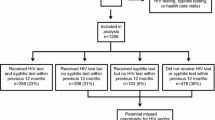Abstract
Little is known about the prevalence and associations of HIV/STI diagnoses and testing behaviors among men who have sex with men (MSM) in Tajikistan. A non-governmental organization conducted a cross-sectional study of MSM (n = 502) assessing laboratory-confirmed HIV/STI diagnoses, HIV/STI testing behavior in the past 6 months, sociodemographics, HIV/STI risk factors, and victimization/discrimination. Overall, 2.6 % were diagnosed with HIV, 2.2 % with syphilis, 17.6 % with chlamydia, and 56.0 % with herpes. Recent testing rates were low for HIV (35.9 %) and STIs (14.1 %). Compared to MSM who completed university, MSM with a high school education or less had lower odds of recent HIV and STI testing; however, victimization and healthcare discrimination were associated with greater odds of recent STI testing. Given the low HIV prevalence, there is a window of opportunity to extinguish the epidemic before it worsens. Non-governmental organizations are indispensable for expanding testing strategies because they can efficiently reach MSM in Tajikistan.
Similar content being viewed by others
References
Beyrer C, Baral SD, van Griensven F, Goodreau SM, Chariyalertsak S, Wirtz AL, et al. Global epidemiology of HIV infection in men who have sex with men. The Lancet. 2012;380(9839):367–77.
Prejean J, Song R, Hernandez A, Ziebell R, Green T, Walker F, et al. Estimated HIV incidence in the United States, 2006–2009. Plos One. 2011;6(8):e17502.
Reynolds R, (ed) Social discrimination against men who have sex with men (MSM) Implications for HIV Policy and Programs. Global Forum on MSM & HIV; 2010.
Arnold EA, Rebchook GM, Kegeles SM. ‘Triply cursed’: racism, homophobia and HIV-related stigma are barriers to regular HIV testing, treatment adherence and disclosure among young Black gay men. Cult Health Sex. 2014;16(6):710–22.
Ayala G, Bingham T, Kim J, Wheeler DP, Millett GA. Modeling the impact of social discrimination and financial hardship on the sexual risk of HIV among Latino and Black men who have sex with men. Am J Public Health. 2012;102(S2):S242–9.
Brondolo E, Gallo LC, Myers HF. Race, racism and health: disparities, mechanisms, and interventions. J Behav Med. 2009;32(1):1–8.
Wilson PA, Valera P, Ventuneac A, Balan I, Rowe M, Carballo-Diéguez A. Race-based sexual stereotyping and sexual partnering among men who use the internet to identify other men for bareback sex. J Sex Res. 2009;46(5):399–413.
Wirtz AL, Kirey A, Peryskina A, Houdart F, Beyrer C. Uncovering the epidemic of HIV among men who have sex with men in Central Asia. Drug Alcohol Depend. 2013;132:S17–24.
National Center for the Prevention and Control of AIDS. The official registration of HIV cases in Tajikistan, 2005–2015. 2015. http://www.nc-aids.tj/statistika.html.
National Progress Report—Tajikistan 2014. UNAIDS, 2015.
The World Bank. Population, total | Data | Graph 2015. http://data.worldbank.org/indicator/SP.POP.TOTL/countries/TJ?display=graph.
Latypov A, Rhodes T, Reynolds L. Prohibition, stigma and violence against men who have sex with men: effects on HIV in Central Asia. Cent Asian Surv. 2013;32(1):52–65.
UNAIDS. UNAIDS report on the global AIDS epidemic (2010). Geneva: UNAIDS, 2012.
Thrasher AD, Earp JAL, Golin CE, Zimmer CR. Discrimination, distrust, and racial/ethnic disparities in antiretroviral therapy adherence among a national sample of HIV-infected patients. J Acquir Immune Defic Syndr. 2008;49(1):84–93.
Ford CL, Daniel M, Earp JA, Kaufman JS, Golin CE, Miller WC. Perceived everyday racism, residential segregation, and HIV testing among patients at a sexually transmitted disease clinic. Am J Public Health. 2009;99(Suppl 1):S137–43.
Marzinke MA, Clarke W, Wang L, Cummings V, Liu T-Y, Piwowar-Manning E, et al. Nondisclosure of HIV status in a clinical trial setting: antiretroviral drug screening can help distinguish between newly diagnosed and previously diagnosed HIV infection. Clin Infect Dis. 2013;58(1):117–20.
Sanchez TH, Kelley CF, Rosenberg E, Luisi N, O’Hara B, Lambert R, et al. Lack of awareness of human immunodeficiency virus (HIV) infection: problems and solutions with self-reported HIV serostatus of men who have sex with men. Open Forum Infect Dis. 2014;1(2):1–7.
Acknowledgments
This study was supported by amfAR (awards 109047 and 108805). Mr. Coulter was partially supported by the National Institute on Drug Abuse (F31DA037647), Mr. Uzzi and Dr. Matthews were partially supported by the National Institute for Mental Health (T32MH094174). This article is solely the responsibility of the authors and does not necessarily represent the official views of amfAR or the National Institutes of Health.
Funding
This study was supported by amfAR (109047-56-HAMM and 108805-55-HAMM), with partial support from the National Institute on Drug Abuse (F31DA037647) and the National Institute for Mental Health (T32MH094174). This article is solely the responsibility of the authors and does not necessarily represent the official views of amfAR or the National Institutes of Health.
Author information
Authors and Affiliations
Corresponding author
Ethics declarations
Conflict of Interest
All authors have no conflicts of interest.
Ethical Approval
All study procedures were approved by both the Bioethics Committee of the Academy of Medical Sciences through the Ministry of Health and Social Welfare of the Republic of Tajikistan and the University of Pittsburgh’s Institutional Review Board. Therefore, all procedures were in accordance with the ethical standards of the institutional and national research committees and with the 1964 Helsinki declaration and its later amendments or comparable ethical standards.
Informed Consent
Informed consent was obtained from all individual participants included in the study.
Rights and permissions
About this article
Cite this article
Gulov, K., Coulter, R.W.S., Matthews, D.D. et al. HIV and STIs Among MSM in Tajikistan: Laboratory-Confirmed Diagnoses and Self-Reported Testing Behaviors. AIDS Behav 20 (Suppl 3), 341–349 (2016). https://doi.org/10.1007/s10461-016-1457-z
Published:
Issue Date:
DOI: https://doi.org/10.1007/s10461-016-1457-z




